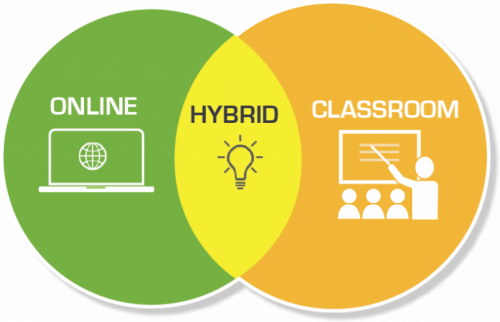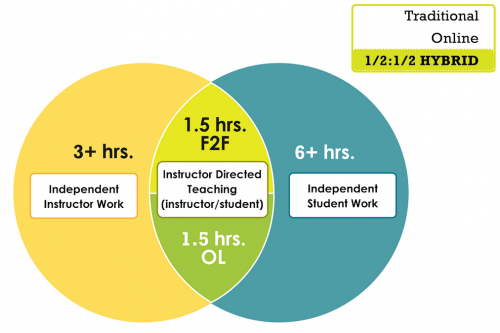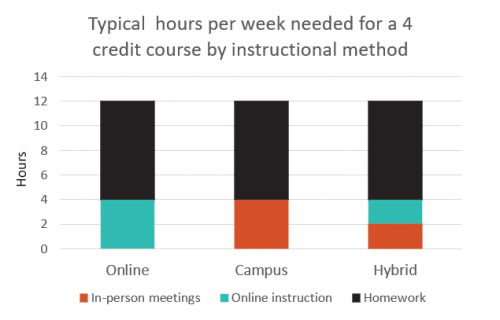This content was published: March 9, 2020. Phone numbers, email addresses, and other information may have changed.
What’s up with hybrids at PCC?
Posted by Greg Kaminski
Editor’s note: Greg Kaminski and Paul Wheatcraft, former hybrid faculty mentor, teamed up to write this post about support for hybrid courses at PCC
Why hybrid? (Paul Wheatcraft)
There are a number of good reasons why a hybrid format can be the best option for a student.
- A hybrid class typically only meets once a week which reduces the number of times that a student has to travel to campus. It also gives more time flexibility since half of the course time can be completed on the student’s own schedule. These aspects are especially beneficial to working students or students with families.
- Students today are very adept with digital technology e.g. Facebook, YouTube, FaceTime. Incorporating these types of digital technology into a hybrid course will encourage better engagement with today’s students.
- It provides the best of both formats: face-face meetings with the instructor for real-time engagement and online flexibility for adapting to students’ schedules.
Finally, a hybrid format allows for more efficient use of classroom space. This means that more classes and students can be served without having to add new facilities. This helps keep costs down which can slow the rise of tuition.
How to transition an existing course to a hybrid

Design concept attribution: Eric Salahub, Front Range CC
So how do you convert an existing face-face or existing online course into a hybrid format? It does take a little work but it is not all that complicated.
Start by examining all the current course activities (e.g. lecture, discussions, written assignments, tests,…) from the perspective “Does this activity work best in an online environment or face-face?”
Next look at the amount of time a student would spend on the face-face or online activities. The ratio of time for a typical hybrid is 50/50. (Some course material may require a different ratio). If your initial assessment does not yield a 50/50 ratio, you should evaluate the activities and perhaps replace one or more. This is actually a healthy exercise because it causes you to reflect on why you included a particular activity in your course.
The key principle when creating a hybrid course is intentionality and planned integration of the course components. Activities that are online should be online because that is the best format for them. Likewise face-face activities should be limited to those that really require / benefit from a classroom setting. From my personal experience, I found that moving the lectures online (recorded videos) meant that I had more face-face time to explore the more difficult / challenging aspects of the course.
Current state of hybrids at PCC (Greg Kaminski)
With the help of various entities, the hybrid faculty work group took significant steps during the past couple of years to improve support of hybrid instruction at PCC. Their report after the initial year included a set of 35 recommendations, about half of which were addressed during the second year. One crucial sustainable achievement was in student awareness – communicating hybrids to students through a new set of course modality icons. You have certainly seen these icons in the schedule.![]()

Another page addresses the question “Are hybrids right for me?” This is an attempt to clarify expectations to students regarding hybrid courses.
The hybrid work group also identified a strong need for hybrid course design training for faculty. Last year, in connection with a President’s Fund award, a team of hybrid faculty mentors designed a hybrid course template along with a half-day workshop on hybrid course design. The hybrid mentor program has ended, but many of the resources are still available. For example, anyone designing or updating a hybrid course has access to the special template designed for hybrids in Brightspace. It’s also possible to import just the introductory modules of the template, which include the hybrid syllabus template and course schedule templates designed for hybrids.
Please visit the Hybrid design resources page for key hybrid resources, including access to the hybrid template in Brightspace, planning tools and video clips from our workshop, advice from the hybrid faculty mentor team, tech support resources, and a number of excellent external resources. If you are interested in the official reports of hybrid work group and the administrative response, you’ll find them on our Hybrid courses page.
Beyond these resources, the current state of supporting hybrid courses is in a holding pattern. The administration is aware of the need, and I expect this topic to be addressed at some point, but I don’t know when. Perhaps it will be integrated into the reorg planning. I am happy to answer questions and provide guidance, even facilitate a workshop for a department or division, so feel free to contact me. We also have D2L Brightspace training provided by our ITS team.
Lessons learned
Be on the lookout for a follow-up blog post from the hybrid faculty mentor team about lessons learned and key strategies for designing and teaching hybrid courses!


This is very helpful, thanks! I would love to see PCC support training for faculty that would like to transition to hybrid courses for lab science classes.
I agree Val, it would be quite helpful. Two of our former hybrid mentors taught hybrid courses that had a lab component (Gretchen Gebhardt and Debby Machuca). Even though the consultation guidance has ended, they might be happy to have a brief chat by phone sometime to share a strategy that worked for them. We might hear more about this in a future blog post as well. Thanks for your comment!
The importance of hybrid classes in the sciences is often missed . Many of our classes have required, face-to-face lab or field components and cannot be taught fully online. More support for these classes is needed.
Very good article Greg and all. I like the graph that shows the expectation of the typical hours of work for a 4 credit class, is about 12 hours, I remind our OL team that it is easy to continue to add things do to, videos to watch or activities students will love to OL (parts of) classes. I caution them to keep in mind that if you have a robust course to begin with, then consider removing activities, videos or things to do before adding more.
I have a detailed list of how much time I “think” an A student is spending on each learning activity in our class. This is based on communicating with A students. I share this in the course so students can plan their time accordingly. I have one student who followed this last year and got A’s on everything, after starting the course terrified!
It is important guide your students to how to study, and not expect them to know how to study in college.
Thanks for sharing these excellent strategies Kathy! That’s a great idea to show the class about how much time a student will likely need to spend in order to get an “A” in the class, and strategies for how to study as well. Time management is so crucial for a hybrid.
How true that it doesn’t work well to just keep adding activities to the online part of an already robust class without giving up something else. This is so easy to do, and the result is the “course and a half syndrome” as discussed by Cub Kahn in his 9-minute video “Effective Practices for Successful Hybrid Course Design.” If there’s an instructor who only has 9 minutes to devote to this topic, this video is a great place to start. (Hybrid design resources page)
I would welcome the opportunity to meld minds with others that teach classes that have labs. The biology SAC policy is that labs are done face to face. I believe there is an opportunity to blend, the fact to face lab with the face to face lecture portion to create a great learning opportunity. If others are interested, I would love to begin a discussion with other faculty on what this would look like in their courses.
This is so timely! Thank you. Many of us are talking about contingency planning for teaching parts of our courses online, so I’m going to make a prediction that we emerge from this COVID-19 crisis with many more innovative ideas that we can use in generating new Hybrid classes. We will still need the funding support for training, but we will be ready!